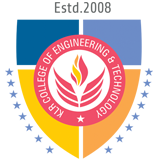About Department
Electrical & Electronics engineering arena stands tall at the front facet of the newest technology. Moving beyond wires and circuits, the discipline now is taking giant strides as it Expanding into cutting-edge technologies. Electrical & Electronics Engineering department was established in the year 2009 offering B.Tech. Programme in Electrical and Electronics Engineering (EEE) with an intake of 60 in B.Tech.
Our department has the fine blend of dynamic and experienced faculty who provide quality education at UG levels. The department has dedicated faculties with a total of 19 teaching and non – teaching staffs. The faculty members are highly qualified and experienced in their areas of specialization. The department has well – qualified faculties who have publications in the reputed National and International Journals.
The department houses well equipped laboratories, while the short-term training programs, seminars, workshops, guest lectures by experts and student fests create better learning scope for students. The department also conducts career development programs, Seminars, Quiz, Industrial Visits, Paper Contests, Group Discussions, Guest Lectures, Career Guidance sessions and games to enhance interpersonal and intrapersonal skills of students.
Vision & Mission
Vision:
To become a Center of Excellence and source of cutting-edge technologies in Electrical and Electronics Engineering and allied fields
Mission:
M1: To enhance career and inculcate spirit of research attitude, foster entrepreneurship through emerging technologies and industry-institute interaction
M2: To impart high quality technical education with problem solving capabilities by innovative pedagogy in emerging technologies.
M3: To imbibe ethical values and leadership skills among student community.
FACULTY
About Head of the Department:

Dr RAKESH TEERDALA, M.Tech, Ph.D
Head of the Department
Dr. Rakesh Teerdala is an accomplished professional in the field of Electrical & Electronics Engineering, currently serving as an Associate Professor and the Head of the Electrical & Electronics Engineering Department at KLRCET. With a rich educational background and a wealth of teaching experience, Dr. Teerdala has made significant contributions to the academic and research communities. Dr. Rakesh earned his PhD in Power Systems from Jawaharlal Nehru Technological University-Hyderabad in 2018, showcasing his commitment to advanced research and expertise in his field. Prior to his doctoral studies, he completed his Master’s degree, M.Tech in Electrical Power Systems, from the same renowned institution in 2011. His educational journey began with a Bachelor’s degree in Electrical & Electronics Engineering from ADAMS Engineering College, Paloncha in 2009.
With a distinguished teaching career spanning 13 years, Dr. Teerdala has played an instrumental role in shaping the future of aspiring engineers. His teaching journey commenced in 2010 at Abdul Kalam Institute of Technological Sciences, where he served as an Assistant Professor. Over the years, he continued to impart knowledge and mentor students, working as an Assistant Professor at Mallareddy Engineering College for Women, Medchel, and also as a Teaching Assistant at JNTUH Hyderabad. His dedication and expertise have culminated in his current role as an Associate Professor and the Head of the EEE Department at KLRCET.
Dr. Rakesh’s research interests encompass a wide range of topics, including FACTS controllers, power electronics applications to power systems, optimization techniques, and power system operation & control. His contributions to the field are evident through his impressive body of work, which includes 2 Indian Patent Publications, 2 Text Books, and 27 National/International Journals & Conferences. His research not only adds to the knowledge base but also has practical applications in the realm of power systems.
LIST OF FACULTY EEE: (Academic Year 2023-24)
S.NO | Name of the Faculty | Designation | Qualification | Experience |
1 | Dr Rakesh Teerdala | Assoc.Prof & HOD | M.Tech, Ph.D | 14 |
2 | Dr P Rajendhar | Assoc.Prof | M.Tech, Ph.D | 12 |
3 | Mr K Gopala Krishna | Asst.Prof | M.Tech | 17 |
4 | Mr Y Heman | Asst.Prof | M.Tech | 12 |
5 | Mr V Naresh | Asst.Prof | M.Tech | 12 |
6 | Mr D V Rama Narsaiah | Asst.Prof | M.Tech | 12 |
7 | Mr M Pavan Kumar | Asst.Prof | M.Tech | 06 |
8 | Mrs K Sindhura | Asst.Prof | M.Tech | 03 |
9 | Mrs B Keerthi | Asst.Prof | M.Tech | 08 |
10 | Mrs B Neelima | Asst.Prof | M.Tech | 08 |
11 | Mrs P Akhila | Asst.Prof | M.Tech | 08 |
12 | Mr K Vijay Kumar | Asst.Prof | M.Tech | 05 |
13 | Mr K Prem Kumar | Asst.Prof | M.Tech | 05 |
14 | Mr M Sumanth | Asst.Prof | M.Tech | 05 |
15 | Mr M Amruth Raj | Asst.Prof | M.Tech | 05 |
16 | Mr Sk Saida Pasha | Asst.Prof | M.Tech | 05 |
17 | Mr Ch Uday | Asst.Prof | M.Tech | 08 |
18 | Mr N NARESH | Asst.Prof | M.Tech | 05 |
19 | Mr MD Ayesh Firdous | Asst.Prof | M.Tech | 05 |
COURSES AND LABORATORIES:
SNO | COURSE | DURATION | SPECIALIZATION |
1 | Diploma | 3 years | Diploma in Electrical and Electronics Engineering |
2 | B.Tech | 4 years | Electrical and Electronics Engineering |
3. | M.Tech | 2 years | Electrical Power Systems |
Program Educational Objectives :
PEO1: To pursue career in the field of Electrical Engineering and allied fields.
PEO2: To pursue higher education and demonstrate skills in research, and emerge as entrepreneur.
PEO3: Exhibit leadership qualities, social and ethical values in the profession.
PSO 1: Expertise in providing solutions for the problems of power systems and allied fields.
PSO 2: Demonstrate sound knowledge, in sustainable energy and smart grid systems.
LABORATORIES
BASIC ELECTRICAL WORKSHOP PRACTICE LAB:
In this laboratory students will able to handle basic electrical and electronics equipment’s, Students will able to do staircase wiring. Students will able to understand domestic wiring procedures practically. Student will able to assemble electronic systems. Students will understand all the fundamental concepts involving electrical Engineering. Students will understand all the fundamental concepts involving electronics engineering.
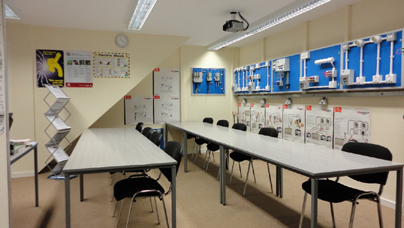 | 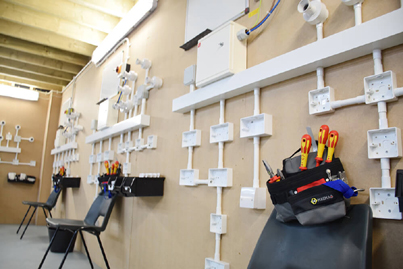 |
WIRING TECHNOLOGY LAB
The residential wiring lab is a wood-framed environment consisting of 10+ lab stations where students install wiring and electrical devices consistent with the National Electrical Code (NEC) standards. Devices include: Panels, breakers, receptacle switches, motion sensors, timers, florescent lighting, recess lighting, and many more. The lab is designed to mimic real-world jobsites and safety is strictly enforced; hard hats are always required. Lab instructors and assistants are available to help students as they work on lab projects that incorporate various sections of the NEC
 |  |
ELECTRICAL MACHINE LAB PRACTICE:
The department has spacious laboratories such as DC Machines lab, AC Machines Lab, Electric Circuits and Devices Lab, Measurement and Instrumentation Lab, Control System Lab, Power Electronics Lab, Microprocessor & Micro controller Lab and Computer & Simulation Lab. All the laboratories are fully equipped with latest, modern and sophisticated equipments.
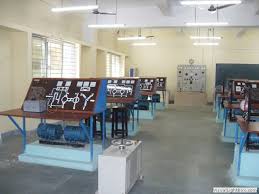 |  |
ELECTRICAL CIRCUITS AND MEASUREMENTS LAB PRACTICES:
An electroniccircuit is composed of individual electronic components, such as resistors, transistors, capacitors, inductors and diodes, connected by conductive wires or traces through which electriccurrent can flow. To be referred to as electronic, rather than electrical, generally at least one active component must be present. The combination of components and wires allows various simple and complex operations to be performed: signals can be amplified, computations can be performed, and data can be moved from one place to another
 | 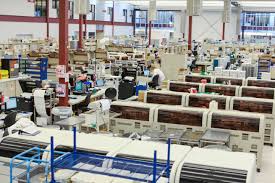 |
ELECTRONICS LAB PRACTICE:
In Electronics lab theoretical concepts of basic electronics presented in a laboratory environment and through practical hands-on experiments. Basic fundamentals of engineering practices covering International System of Units, engineering notation and prefixes definitions of current, voltage, resistance, power, work and efficiency, Ohm’s and Kirchhoff’s Laws, series and parallel circuit principles, and series-parallel DC resistive networks are examined.
 | 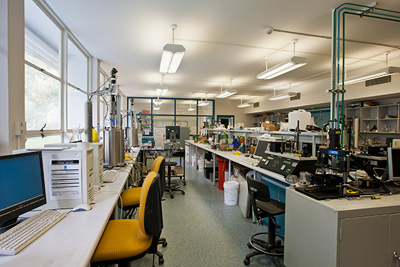 |
DIGITAL ELECTRONICS AND MICROCONTROLLERS LAB PRACTICE:
Digitalelectronics or digital (electronic) circuits are electronics that operate on digitalsignals. In contrast, analog circuits manipulate analog signals whose performance is more subject to manufacturing tolerance, signal attenuation and noise. Digital techniques are helpful because it is a lot easier to get an electronic device to switch into one of a number of known states than to accurately reproduce a continuous range of values.
 |  |
ELECTRICAL CAD AND PLC LAB:
The first application of CAD was in the electronics industry. With the increasing complexity of electronic devices, computers have become imperative in electricaldesign. Integrated circuits (ICs) are a good example of this developed dependency on CAD. Each integrated circuit used to have less than thirty transistors and a thousand geometries (geometric patterns). Now, these numbers have risen drastically. With over one million transistors and ten million geometries per IC, the conventional method of design is no longer an option.
 | 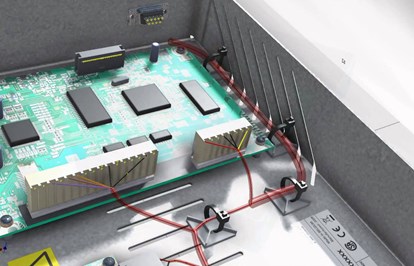 |
POWER ELECTRONICS LAB:
Power electronics started with the development of the mercury arc rectifier. Invented by Peter Cooper Hewitt in 1902, it was used to convert alternating current (AC) into direct current (DC). From the 1920s on, research continued on applying thyratrons and grid-controlled mercury arc valves to power transmission. Uno Lamm developed a mercury valve with grading electrodes making them suitable for highvoltage direct current power transmission. In 1933 selenium rectifiers were invented.
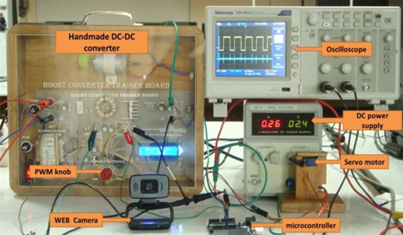 | 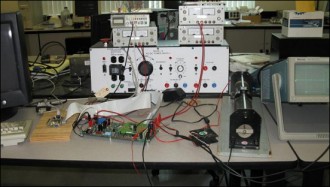 |
